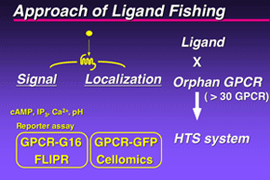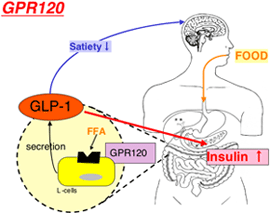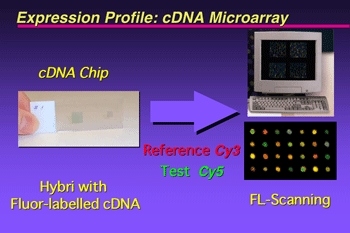| |
 |
 |
| |
| Home | Project | People | Research | Education | Archive | |
 |
Pharmacogenomics |
[English | Japanese ] |
 |



 |
  |
 |
Gozoh
Tsujimoto
Professor,
Graduate
School of Pharmaceutical Sciences,
Kyoto University |
Novel drug discovery based on
the genomic information
About 3 billion base pairs of the human genome was completely sequenced. However, there still is a lot of works remained to do for understanding what kind of role for each gene to play. The genomic drug discovery science is the science field of discovery of the new drug, the medicine of the effect to be higher and the medicine with few side effects, using the genome information.
1. Functional genomics of G protein-coupled receptors (GPCR)
Information from genome sequencing estimated the existence of 700-800 GPCRs
in the human genome: about 250 of GPCRs are identified as receptors for
known ligands, and the rest are still orphan receptors (oGPCRs). Recognized
for the potential of oGPCRs as targets of novel drug discovery, oGPCRs
have attracted a tremendous level of attention in terms of continued identification
of their endogenous ligands and elucidation of their physiological functions.
Attempts to study the targeted molecule distribution at the subcellular
level have been limited by the lack of specific structural probes of GPCRs.
Functional GPCR-GFP (green fluorescent protein) fusion molecules are important
tools for optical measurement of biochemical and biophysical processes
that are relevant to the signal transduction of GPCRs (Figure 1). Very
recently, we successfully identified natural ligand (free fatty acid) for
orphan GPCR GPR120. GPR120 localizes in the intestinal tract and regulates
the secretion of the most potent insulin-secreting peptide hormone GLP-1;
hence, this GPCR would be a good candidate for anti-diabetic drugs (Figure
2).
 |
|
 |
Fig.1. Cell-base screening
system for ligand fishing
|
|
Fig. 2. Successful
de-orphaning of GPR120
|
2. Functional genomics by microarray DNA Chip
A microarray is one of the most important basic technology for drug discovery
from the aspect of genomics (Figure 3). The focus of genome research will be
shifted to functional analysis of genes including the determination of precise
transcript unit as transcriptome. The gene expression pattern (i.e. profile)
of disease specific status could be obtained by DNA chip technology that makes
it accelerate to find candidate molecules of drug target. We are interested
in the construction of databases of gene expression data, gene expression analysis
of disease model animals and human disease status (such as cancer, nephritis,
diabetic nephropathy, etc), and finally discovering the candidate molecule
of the effective novel drug target and revealing the mechanisms of human disorders.
 Fig. 3. Microarray
Fig. 3. Microarray
|
Top
| 2007 | 2006 | 2005 | |
|
|

